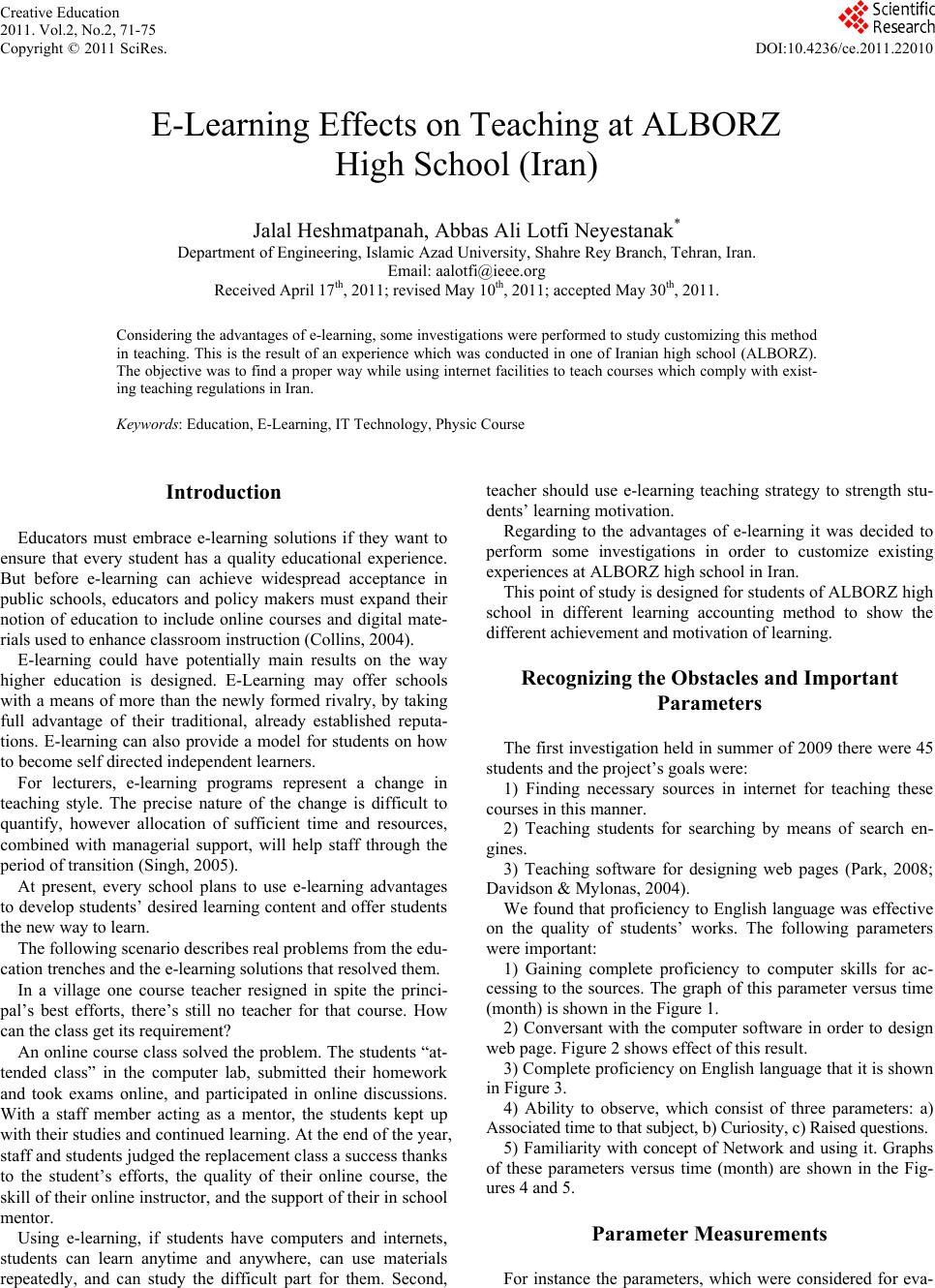
Creative Education
2011. Vol.2, No.2, 71-75
Copyright © 2011 SciRes. DOI:10.4236/ce.2011.22010
E-Learning Effects on Teaching at ALBORZ
High School (Iran)
Jalal Heshmatpanah, Abbas Ali Lotfi Neyestanak*
Department of Engineering, Islamic Azad University, Shahre Rey Branch, Tehran, Iran.
Email: aalotfi@ieee.org
Received April 17th, 2011; revised May 10th, 2011; accepted May 30th, 2011.
Considering the advantages of e-learning, some investigations were performed to study customizing this method
in teaching. This is the result of an experience which was conducted in one of Iranian high school (ALBORZ).
The objective was to find a proper way while using internet facilities to teach courses which comply with exist-
ing teaching regulations in Iran.
Keywords: Education, E-Learning, IT Technolog y, Physic Course
Introduction
Educators must embrace e-learning solutions if they want to
ensure that every student has a quality educational experience.
But before e-learning can achieve widespread acceptance in
public schools, educators and policy makers must expand their
notion of education to include online courses and digital mate-
rials used to enhance classroom instruction (Collins, 2004).
E-learning could have potentially main results on the way
higher education is designed. E-Learning may offer schools
with a means of more than the newly formed rivalry, by taking
full advantage of their traditional, already established reputa-
tions. E-learning can also provide a model for students on how
to become self directed independent learners.
For lecturers, e-learning programs represent a change in
teaching style. The precise nature of the change is difficult to
quantify, however allocation of sufficient time and resources,
combined with managerial support, will help staff through the
period of transition (Singh, 2005).
At present, every school plans to use e-learning advantages
to develop students’ desired learning content and offer students
the new way to learn.
The following scenario describes real problems from the edu-
cation trenches and the e-learning solutions that resolved them.
In a village one course teacher resigned in spite the princi-
pal’s best efforts, there’s still no teacher for that course. How
can the class get its requirement?
An online course class solved the problem. The students “at-
tended class” in the computer lab, submitted their homework
and took exams online, and participated in online discussions.
With a staff member acting as a mentor, the students kept up
with their studies and continued learning. At the end of the year,
staff and students judged the replacement class a success thanks
to the student’s efforts, the quality of their online course, the
skill of their online instructor, and the support of their in school
mentor.
Using e-learning, if students have computers and internets,
students can learn anytime and anywhere, can use materials
repeatedly, and can study the difficult part for them. Second,
teacher should use e-learning teaching strategy to strength stu-
dents’ learning motivation.
Regarding to the advantages of e-learning it was decided to
perform some investigations in order to customize existing
experiences at ALBORZ high school in Iran.
This point of study is designed for students of ALBORZ high
school in different learning accounting method to show the
different achievement and motivation of learning.
Recognizing the Obstacles and Important
Parameters
The first investigation held in summer of 2009 there were 45
students and the project’s goals were:
1) Finding necessary sources in internet for teaching these
courses in this manner.
2) Teaching students for searching by means of search en-
gines.
3) Teaching software for designing web pages (Park, 2008;
Davidson & Mylonas, 2004).
We found that proficiency to English language was effective
on the quality of students’ works. The following parameters
were important:
1) Gaining complete proficiency to computer skills for ac-
cessing to the sources. The graph of this parameter versus time
(month) is shown in the Figure 1.
2) Conversant with the computer software in order to design
web page. Figure 2 shows effect of this result.
3) Complete proficiency on English language that it is shown
in Figure 3.
4) Ability to observe, which consist of three parameters: a)
Associated time to that subject, b) Curiosity, c) Raised questions.
5) Familiarity with concept of Network and using it. Graphs
of these parameters versus time (month) are shown in the Fig-
ures 4 and 5.
Parameter Measurements
For instance the parameters, which were considered for eva-